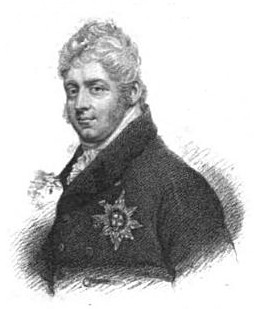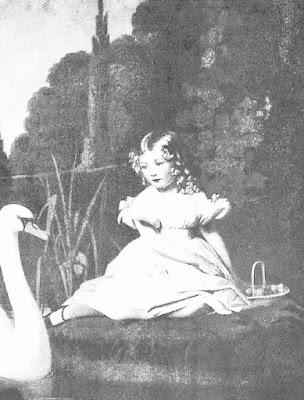 |
Augusta, Duchess of Cambridge
from La Belle Assemblée (1830) |
Profile
Birth of a German princess
Princess Augusta Wilhelmina Louisa was born in Cassel on 25 July 1797, the third daughter of Frederick, Landgrave of Hesse-Cassel, and his wife Caroline Polyxena of Nassau-Usingen.1
A royal marriage
On 7 May 1818, Augusta married her second cousin, Adolphus, Duke of Cambridge, the seventh son of George III, in Cassel.2
 |
Adolphus, Duke of Cambridge
from A Biographical Memoir of Frederick,
Duke of York and Albany by John Watkins (1827) |
Adolphus wrote soon after his engagement:
Every hour I feel that my esteem and attachment for my bride increase; and she really is everything both as to heart, mind and Person that I could wish.3
The marriage ceremony was repeated at the Queen’s Palace—Buckingham House—on 1 June.4
According to La Belle Assemblée:
A temporary altar was fixed in her [the Queen’s] blue drawing-room, and the Duke and Duchess were again united in presence of her Majesty, the Prince Regent, the royal Dukes, and the Princesses their sisters. The ceremony was performed by the Archbishop of Canterbury, assisted by the Bishop of London. A royal salute was, as usual, fired at this conclusion of the ceremony, and a splendid dinner, in honour of the nuptials, given by the Prince Regent.5
A happy marriage
Thank God my dearest Adolphus’ mind is at ease about the Duchess of Cambridge; she has given him another little girl…She was woefully alarmed about herself, which affected him, as he adores her to a degree that almost made him ill.6
Until 1837, Adolphus and Augusta lived in Hanover where the Duke was Governor General and, from 1831, Viceroy.
Family life
Adolphus and Augusta had three children: George William Frederick Charles (1819), Augusta Caroline (1822) and Mary Adelaide (1833). They liked to have their children with them and frequently provided dances and the like for their amusement.
At the age of eleven, George was sent to England to be educated at Windsor. Augusta took Mary to England when she was three to stay at Windsor, but although she was always welcomed by William IV and Queen Adelaide, Augusta was not a good traveller and avoided the journey whenever possible.
 |
Princess Mary Adelaide aged 4 from
A Memoir of Princess Mary Adelaide of Teck
by Sir Clement Kinloch-Cooke (1900) |
Return to England
In 1837,
William IV died and
Ernest, Duke of Cumberland, the Duke of Cambridge’s eldest surviving brother, became King of Hanover. On 1 September, the Duke and Duchess of Cambridge left Hanover for England, where they took up residence in London at Cambridge House, 94 Piccadilly.
Cambridge Cottage
In the summer of 1838, Augusta and Adolphus moved to Cambridge Cottage in Kew. An eastern wing and a portico were added to the house which had been used many years before by
Prince Edward, Duke of Kent, and Prince William, Duke of Clarence, later William IV. It is believed that George III gave the house to Adolphus in 1801 when he was made Duke of Cambridge.
Augusta loved Kew and spent a lot of her time outside, playing with her younger daughter, Mary Adelaide, and tending the garden. She drove a light pony carriage around the grounds. Her favourite seat was under a horse chestnut tree outside the dining room and throughout the summer, Augusta received visitors there and served tea in its shade.
 |
Cambridge Cottage from A Memoir of Princess Mary Adelaide
of Teck by Sir Clement Kinloch-Cooke (1900) |
A keen gardener
Augusta introduced two lilacs from her family home in Germany and sought out new plants for the garden including rhododendrons. Mary Adelaide grew up sharing her love of the garden. The family were lifelong friends with the director of the
Botanic Gardens, Sir William Hooker, and later his son, Sir Joseph.
Visitors
Cambridge Cottage received many visitors including the young Prince of Wales, the future Edward VII, who rowed up the Thames to visit his aunt and cousin. It was here that the Prince of Wales attended his first dinner party. Maybe it was fond memories of this time that inspired the match between the Prince of Wales’ son, the future George V, and Mary Adelaide’s daughter, Mary of Teck.
What was the Duchess of Cambridge like?
 |
Augusta, Duchess of Cambridge
from La Belle Assemblée (1818) |
According to Kinloch-Cooke, the Duchess of Cambridge was
...a handsome, stately lady somewhat above the average height of women...Her features were striking, and the dark eyes and eyebrows made her appearance most attractive...perfectly shaped hands...a charming smile.7
Augusta was an efficient and kindly mistress, managing the household herself. She loved reading and being read to, was a good conversationalist and had a keen interest in politics. She and Adolphus both enjoyed music and regularly attended the opera, but according to Princess Elizabeth, her “sister-in-law’s passion is the theatre.”8
Augusta liked to be busy, whether tending the garden or working on a piece of needlework or knitting. Like her husband, she was very charitable and strove to help the poor of Kew as well as supporting charities back in Germany.
Years of widowhood
Adolphus died in 1850. Augusta continued to live mostly at Kew. It was from Cambridge Cottage that Mary Adelaide was married to the Duke of Teck on 12 June 1866, in the local church at Kew. In the days running up to the wedding, there was a banquet and ball at Kew and two tents were erected in the garden in order to accommodate 140 people at dinner.
 |
Princess Mary Adelaide from
A Memoir of Princess Mary Adelaide of Teck
by Sir Clement Kinloch-Cooke (1900) |
During the London season, Augusta stayed at St James’ Palace. She entertained a great deal both at home and in London and was close to
Princess Mary, Duchess of Gloucester, and sometimes dined with the Duchess of Inverness, the
Duke of Sussex’s second wife.
Together with Mary Adelaide, she attended the opening of the Crystal Palace in 1854 and attended a ball in the Waterloo Gallery at Windsor.
A beloved old lady
By 1875, Augusta was an invalid. Her solace in her affliction was music and visits from her friends and family, especially Mary Adelaide and her children.
Mary Adelaide wrote of her mother:
She is carried down to the drawing-room every day about two o’clock, and after her early dinner at three is wheeled into the garden in a delightful chair, and when fine remains out till after seven, sometimes taking a turn in the great gardens, for her chair can either be drawn by hand or a pony.9
The chair was a gift from Queen Victoria.
Augusta survived her husband by almost 40 years, dying at St James’ Palace on 6 April 1889 at the age of 91. She was buried at St Anne’s Church, Kew, but her remains were later transferred, with those of her husband, to the royal vault in
St George’s Chapel, Windsor.
Rachel Knowles writes clean/Christian Regency era romance and historical non-fiction. She has been sharing her research on this blog since 2011. Rachel lives in the beautiful Georgian seaside town of Weymouth, Dorset, on the south coast of England, with her husband, Andrew.
Find out more about Rachel's books and sign up for her newsletter here.
If you have enjoyed this blog and want to encourage me and help me to keep making my research freely available, please buy me a virtual cup of coffee by clicking the button below.
Notes
(1) Modern day Kassel – it was spelt Cassel until 1928.
(2) Augusta’s father was the son of Princess Mary, a daughter of George II, and sister of Frederick, Prince of Wales, George III’s father. This made Augusta’s father and George III first cousins and their children, Augusta and Adolphus, second cousins.
(3) In a letter from Adolphus to Lady Harcourt in A Memoir of Princess Mary Adelaide of Teck by Sir Clement Kinloch-Cooke (1900).
(4) La Belle Assemblée said 2 June.
(5) From La Belle Assemblée (August 1818).
(6) In a letter from Princess Elizabeth to a Miss Swinburne dated 4 December 1833 in A Memoir of Princess Mary Adelaide of Teck by Sir Clement Kinloch-Cooke (1900).
(7) In A Memoir of Princess Mary Adelaide of Teck by Sir Clement Kinloch-Cooke (1900) p26.
(8) In a letter by Princess Elizabeth in A Memoir of Princess Mary Adelaide of Teck by Sir Clement Kinloch-Cooke (1900).
(9) In a letter from Princess Mary of Teck to a friend dated 9 August 1875 in A Memoir of Princess Mary Adelaide of Teck by Sir Clement Kinloch-Cooke (1900).
Sources used include:
La Belle Assemblée (1818 and 1830)
Kinloch-Cooke, Clement Sir, A Memoir of Princess Mary Adelaide of Teck (1900)
Cotton, AD, The Cambridge Cottage Garden, published as a supplement to The Journal of the Kew Guild (1942)
Palmer, Alan, Adolphus Frederick, Prince, first Duke of Cambridge, (1774-1850), Oxford Dictionary of National Biography, (Oxford University Press, 2004, online edn, May 2009, accessed 23 Mar 2013)








Thanks. Not a well known lady today. I think she was too good and too normal to be much written about.
ReplyDeleteI didn't plan to write this blog at all, but found myself being drawn into her story. As you say, she sounds like a very good and normal lady - very different from most of the royals of her time!
Delete